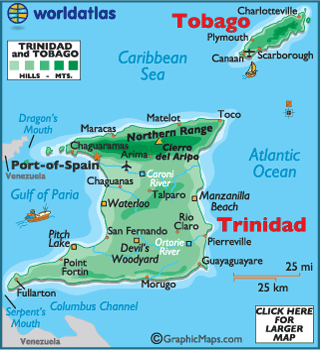|
Trinidad and Tobago - What You Would Want to KnowThe nation of Trinidad and Tobago is renown for its carnival and idyllic beaches. A particularly novel aspect of this twin island country is its carnival. In fact, information about carnival are still hot search topics in Google.
Also, around that time, the news papers like the Trinidad and Tobago Newsday, Express and Guardian are awash with their coverage of what is dubbed by some as the greatest event in the world.
Trinidad and Tobago are two islands of a single nation of the same name. Situated in the south Atlantic, Trinidad and Tobago boasts a proud history that is not only rich in wealth but also in racial and cultural diversity.
Cultural and Racial Balance
The people of Trinidad and Tobago are made up primarily of East Indian and African descent. For most of its history since colonization, people of African decent were the majority of the population.
However, in recent years, that has changed and those of East Indian decent are now the majority of the population.
The 2000 population census found the population mix to be:
Short History of the Reason for the Racial MixHaving changed hands from one European nation to another, Tobago even more so, the last European country to own Trinidad and Tobago was England.
England combined the two islands into the colony of Trinidad and Tobago in 1886( they gained independence in 1962 and became a Republic in 1976).
As a slave colony, the islands remained a profitable economic base for England primarily due to sugar production.
Agriculture thrived on the backs of African slaves. However, slavery was abolished in the British Empire in 1834 with a four year emancipation period before the abolition was fully effected in 1838.
During that time, there were tens of thousands of slaves in Trinidad and Tobago who were now free. This, however, left a jobs deficit for the British Plantation owners.
To fill this employment gap, they had to import indentured servants. The bulk of these came from India and a small amount were made up of Chinese and Portuguese. They mainly settled in Trinidad.
Tobago pretty much remained almost exclusively Afro-centric, although that has started to change.
Until fairly recently, the racial makeup throughout Trinidad and Tobago favored those of African descent. The racial balance has since shifted in favor of those of East Indian descent who now are in the majority in the population.
Trinidad and Tobago - The Wealthiest Caribbean Nation
By the 1950s, agriculture which was the main stay of the economy in Trinidad and Tobago was giving way to petroleum products. By this time, the agricultural industry which comprised primarily of sugar, cocoa and citrus was becoming unprofitable for a multiplicity of reasons. Petrochemicals
Notwithstanding, thanks to the growing petroleum industry resulting in a great export product, oil, Trinidad and Tobago fortunes were changing for the better. There was a growing middle and upper class as the nation’s wealth rippled throughout the land.
Still, Trinidad and Tobago was not selfish with its new found wealth. The nation became the lender of first resort to many of its Caribbean neighbors.
Nevertheless, agriculture continued on a steady decline and in most cases had to be subsidized. Today petroleum products account of over 40% of the national wealth. This has created a problem, even though nothing untoward has yet occurred.
It is a problem of risk. This one-sidedness and over dependence on a single product has left the country overexposed to the vagaries and fickleness of the energy market. Prudence requires some diversification if economic stability is to be ensured.
DiversificationTrinidad and Tobago are trying to divest away from the over dependence on oil. One way is still in the field of petrochemicals.
Liquefied Natural Gas (LNG)The country has focused on developing natural gas, which does not share the same volatility as oil, and is now the biggest liquefied natural gas (LNG) exporter in the western hemisphere.
They are the chief exporter of liquefied natural gas to the United States. More than 40% of the United States of America’s imported liquefied natural gas (LNG) comes from Trinidad and Tobago. Trinidad and Tobago are even in consultation to help Ghana establish it’s own LNG plant.
TourismAnother effort to diversify is in the area of tourism. In more recent years, tourism has been on the upturn in Trinidad and Tobago. Tobago is chiefly responsible for this because of its unique beauty and pageantry.
However, tourism has taken a hard hit since 2009. Although there has been some local finger pointing for the cause of this, the real reason is the global recession of 2008 and 2009.
The major blow to the world economy prevented many, who otherwise would, from traveling.
The US Department of State recently published a very comprehensive profile of Trinidad and Tobago....
Do you have an interesting story or experience about Trinidad and Tobago? We would be happy if you share it.
Sound of in the form below.
Have A Great Story About This Topic?Have a story about this topic or about any thing in or about Tobago?
Back to Top: Trinidad and Tobago / Trinidad Trips to Tobago/ Tobago Guest Houses / Tobago Hotels/ Tobago Real Estate/ Married in Tobago/ Tobago Pictures Gallery/ Home/ Tobago house rentals/ Tobago car rentals /
|
 Map of Trinidad and Tobago
Map of Trinidad and Tobago
